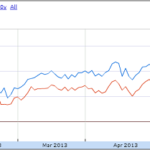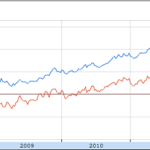Consumer staples companies – those that make goods that consumers buy time and time again – are known for being leaders in low volatility returns from the equity markets. Consumer staples companies include well known names like Procter & Gamble (PG), Coca-Cola Co (KO), or Colgate-Palmolive (CL).
Why Invest in Consumer Staples
Consumer staples stocks benefit from a number of advantages:
Demand for their products is inelastic – Whereas global consumers will cut back on trips to visit Las Vegas Sands Corp. (LVS) casinos during a recession, companies like Wal-Mart Stores (WMT) sell just as much product.
Rising population and wealth is free growth – While few consumer staples companies can put up double digit growth year after year due to their existing size, their customer base tends to grow with population growth. Consumer staples funds also give investors exposure to a growing middle class in emerging markets like Brazil, Russia, India, and China.
Moats are the strongest – Consumer staples companies have some of the world’s best brands, best distribution networks, and scale which all protect their businesses from the threat of competition. Regulation also benefits these behemoths. Altria (MO) is one of the biggest beneficiaries of a regulated industry, as it keeps away startup-sized competitors.
As a sector, the consumer staples sector is most insulated from recessions, volatility in share prices, and competition. Let’s look at a few ETFs that track this sector and examine their performance.
The Three Best Consumer Staples ETFs
There are more than 14 different consumer staples funds, but the three below have been selected for their diverse holdings, long-term track records, and low expense fees.
- Consumer Staples Select Sector SPDR (XLP) – The SPDRs are among the best known sector funds, and State Street’s brand is just as popular in consumer goods. The fund has more than $5.8 billion in assets, which is invested in a variety of 43 American consumer goods companies. Market cap weighted, the fund is most aggressively invested in large cap stocks like Proctor and Gamble (PG), Phillip Morris International (PM), and Coca-Cola (KO), which are all weighted at more than 10% of the fund. The expense ratio of .18% per year makes this an affordable way to play large cap consumer staples. Total returns in the past five years were 35.46%.
- Vanguard Consumer Staples ETF (VDC) – This fund does not diverge from Vanguard’s typical product. Having the lowest expense fee of .14% and wide diversification into 109 US-listed stocks, this fund makes for a good large and small cap play on typical consumer staples stocks. The top three holdings are the same as the SPDR fund, but are weighted less aggressively to make room for many more holdings than competing funds. Five-year total returns amount to 37.88%.
- iShares S&P Global Consumer Staples (KXI) – iShares’ global staples fund brings some currency risk (or potential!) that other funds do not. This globally diversified fund holds 115 different stocks with half of the fund’s assets invested in U.S.-listed names and the other half invested in companies that list around the world. Top holdings include Nestle SA (NSRGF), Procter & Gamble Co (PG), and Philip Morris International, Inc. (PM). This fund gives investors exposure to the world without accepting exceptional risk. Consider the iShares S&P Global Consumer Staples (KXI) as a way to inexpensively chase returns overseas. The fund’s annual expense ratio of .48% is in line with most international stock ETFs. Five-year total returns are 30.54%.
Consumer staples would be best for investors who want less volatility with stock market-like returns. Previously, we’ve written on the topic of low volatility ETFs, which have rewarded investors with the same returns as the S&P 500 with less volatility.
These funds could be seen as an alternative to low volatility ETFs, as they are all less volatile than the broad market. This ETF is much more simple than low volatility funds; it achieves lower volatility by investing in businesses that are inherently less volatile than those in other sectors.
Disclosure: No position in any tickers mentioned here.











{ 0 comments… add one now }